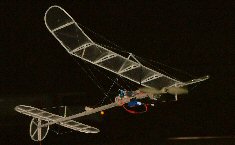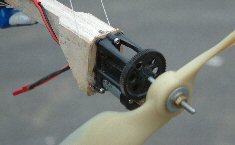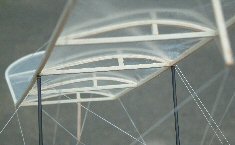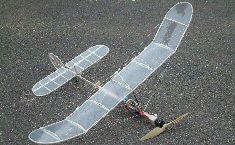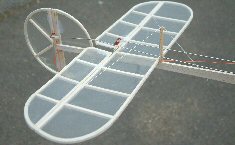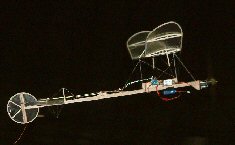|
|||
|
|
|
||
| View Shopping Cart |
| Home |
| Guides Available |
| About the Author |
| FAQs |
| Testimonials |
| Articles |
| Contact Andrew |
| Terms & Conditions |
| Mailing List |
| Links |
 |
 |
More high quality information absolutely
free with every
Gibbs Guides newsletter. Sign
up now!
Wes Edwards' Chimera (free plan available)
Article by Andrew Gibbs
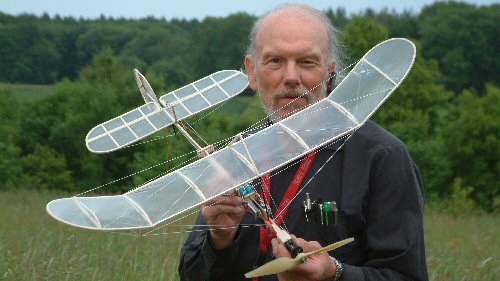
This delightful model really appealed to me when I saw it flying slowly and gracefully at an informal indoor flying meeting. The model was designed and built by Wes Edwards, a long time aeromodeller. Wes says the inspiration for this RC electric design is the indoor competition rubber models that he used to build in earlier times.
Chimera has a span of 30 inches (760mm) and the wing chord is about 4½ inches, (116mm), giving an area of 130 sq in. The model is 28 inches in length. It weighs 132g (4.6oz) ready to fly, giving a wing loading of just under 5oz/sq ft.
| Chimera makes a slow and graceful fly past for the camera | A brushed, geared GWS motor powers the model. A small brushless motor could also have been be used. |
One of the attractions of this model is its economy; instead of buying new components, Wes has utilised a variety of components left over from other projects. One example of this is the electric power system which consists of a GWS geared brushed motor which is supplied by a 2S 350mAh LiPo and which drives an APC 9x6 propeller. The full throttle current of this combination is just 700mA. The ESC is rated at 10 Amps and so is much larger than is necessary, but it was used as it was in stock. Wes used 35MHz gear for this model, and has experienced no problems with reception.
The design skill and extensive modelling experience which Wes has accumulated is evident in this design - every part of the model is doing a job, and there are no unnecessary components.
| The power and control equipment is very simple. | The wing requires very few components. The highly cambered surface is covered only on its top surface. |
The model’s structure is all balsa. The wings and tail surfaces are made from 1/8" (3mm) square strip. The wing and tail tips are made from 3 laminations of 1/32" (0.8mm) balsa around a former. The fuselage is built from 1/8" (3mm) sheet. The wing posts were originally of balsa, but these were replaced with off cuts of 2mm carbon tube. Wes uses this tube as guides for 1mm pushrods in his larger electric models. The rigging, which is essential for strength and stiffness is actually dental floss, while the pushrods are made from 1 mm stainless steel welding rods. The covering is a transparent lightweight laminating film, applied only to the top of the flying surfaces. This conveniently represents the microfilm covering of the ultra-light rubber power indoor models which provided the inspiration for this project.
This model is delightful, and is to my mind a very successful exercise in simple, low cost modelling – the structure has a very low materials cost, and since all of the installed components were taken from the spares box, there was very little cost there, either.
| Chimera makes another fly past for the camera. | A simple model like this won't take long to build. |
Obviously if he had wanted to spend more funds on lighter components, Wes could easily have made significant weight savings, but this really was not necessary – as it stands, the model flies very well, and has a low flying speed. I’m a fan of recycling, and in these recessionary times, avoiding unnecessary expense is a particularly important virtue.
| The tail of the model is a light and simple all balsa structure. It is braced for additional rigidity. | Since this picture was taken, the model has grown an undercarriage, adding to the fun than the model can provide. |
I observed that the model was very controllable, and it repeatedly made easy, tight turns. The low wing loading, low power and relatively high drag makes the model a very slow and flyer which could easily be flown in quite a small hall. The combination of controllability and low flying speed make the likelihood of contact with walls low, and if impacts do take place the very low inertia means any damage will probably be minimal or even nil.
My feeling is that with the popularity of indoor models growing, we could see a lot more models of this type. The genre lends itself admirably to all kinds of variations and is a wonderful quick and low cost vehicle for experimental design. Biplanes, canards and many more types could easily be built.
Wes has named his model Chimera, one of the definitions of which is a mythical flying beast composed of parts of several different animals. As Wes says, ‘Quite appropriate, I think!’
Thanks for sharing your absolutely delightful model Wes!
Update - Chimera plan
Please note that a downloadable plan and associated building
notes are now available for this model at no charge using
the links below. The plan can be printed in 'tiles' using
an ordinary printer, using the poster option in the print
menu. After printing, the tiles are taped together. If
you build a Chimera, please let us know how you get on!
Click here for your Chimera plan
Click here for the Chimera builder's guide
| Chimera technical data | ||
| Span | 760mm | 30 inches |
| Chord | 116mm | 4.5 inches |
| Wing Area |
0.00 sq m | 0.9 sq ft (130 sq in) |
| Flying Weight | 132g | 4.6oz |
| Wing Loading | 00g/dm | 5 oz/sq ft |
| Battery | 2S 350mAh LiPo | |
| Motors | GWS brushed (unknown Kv) | |
| Prop | 9x6 APC | |
| Max Power | 700mA = approx 5 Watts | |
| Power Loading (max power) | 000 W/kg | Approx 18 W/lb |
| Endurance | More than 15min | |
| Control functions | Elevator, rudder, throttle. | |
More high quality information
absolutely free with every
Gibbs Guides newsletter. Sign
up now!
